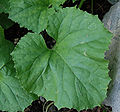Honeydew (melon)
Honeydew (melon)
The Honeydew is a cultivar group of the muskmelon, Cucumis melo Inodorus group, which includes cantaloupe and other sweet melons. Honeydew has a round to slightly oval shape, typically weighing between 1.8 to 3.6 kg (4-8 lbs). The flesh is usually pale green, while the smooth peel ranges from greenish to yellow.
Description[edit]
Honeydew melons are characterized by their smooth, firm outer skin that encases a sweet, juicy, green-colored flesh. The melon's high water content and potent combination of vitamins and minerals make it a nutritious addition to any diet.
Cultivation[edit]
Honeydew melons are grown in semiarid climates, with the majority of commercial production occurring in California, Arizona, and Texas. They are typically planted in the spring and harvested in late summer or early fall.
Nutritional Value[edit]
Honeydew melons are low in calories and high in vitamin C and potassium. They also contain B vitamins including thiamine, niacin, and pantothenic acid, as well as trace amounts of iron and zinc.
Health Benefits[edit]
Honeydew melons have several health benefits. They are a good source of antioxidants, which can help to prevent a range of diseases and conditions. The high water content can aid in hydration, and the fiber content can support digestive health.
Culinary Uses[edit]
Honeydew melons are often eaten fresh in slices or as part of a fruit salad. They can also be used in smoothies, desserts, or as a garnish for savory dishes.
| 🌱 | This Cucurbitaceae related article is a stub. |
-
Honeydew melon
-
Honeydew melon flower
-
Honeydew melon leaf
Ad. Transform your life with W8MD's Budget GLP-1 injections from $75


W8MD offers a medical weight loss program to lose weight in Philadelphia. Our physician-supervised medical weight loss provides:
- Weight loss injections in NYC (generic and brand names):
- Zepbound / Mounjaro, Wegovy / Ozempic, Saxenda
- Most insurances accepted or discounted self-pay rates. We will obtain insurance prior authorizations if needed.
- Generic GLP1 weight loss injections from $75 for the starting dose.
- Also offer prescription weight loss medications including Phentermine, Qsymia, Diethylpropion, Contrave etc.
NYC weight loss doctor appointmentsNYC weight loss doctor appointments
Start your NYC weight loss journey today at our NYC medical weight loss and Philadelphia medical weight loss clinics.
- Call 718-946-5500 to lose weight in NYC or for medical weight loss in Philadelphia 215-676-2334.
- Tags:NYC medical weight loss, Philadelphia lose weight Zepbound NYC, Budget GLP1 weight loss injections, Wegovy Philadelphia, Wegovy NYC, Philadelphia medical weight loss, Brookly weight loss and Wegovy NYC
|
WikiMD's Wellness Encyclopedia |
| Let Food Be Thy Medicine Medicine Thy Food - Hippocrates |
Medical Disclaimer: WikiMD is not a substitute for professional medical advice. The information on WikiMD is provided as an information resource only, may be incorrect, outdated or misleading, and is not to be used or relied on for any diagnostic or treatment purposes. Please consult your health care provider before making any healthcare decisions or for guidance about a specific medical condition. WikiMD expressly disclaims responsibility, and shall have no liability, for any damages, loss, injury, or liability whatsoever suffered as a result of your reliance on the information contained in this site. By visiting this site you agree to the foregoing terms and conditions, which may from time to time be changed or supplemented by WikiMD. If you do not agree to the foregoing terms and conditions, you should not enter or use this site. See full disclaimer.
Credits:Most images are courtesy of Wikimedia commons, and templates, categories Wikipedia, licensed under CC BY SA or similar.
Translate this page: - East Asian
中文,
日本,
한국어,
South Asian
हिन्दी,
தமிழ்,
తెలుగు,
Urdu,
ಕನ್ನಡ,
Southeast Asian
Indonesian,
Vietnamese,
Thai,
မြန်မာဘာသာ,
বাংলা
European
español,
Deutsch,
français,
Greek,
português do Brasil,
polski,
română,
русский,
Nederlands,
norsk,
svenska,
suomi,
Italian
Middle Eastern & African
عربى,
Turkish,
Persian,
Hebrew,
Afrikaans,
isiZulu,
Kiswahili,
Other
Bulgarian,
Hungarian,
Czech,
Swedish,
മലയാളം,
मराठी,
ਪੰਜਾਬੀ,
ગુજરાતી,
Portuguese,
Ukrainian




